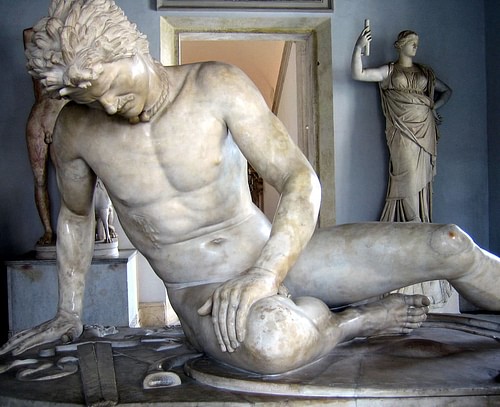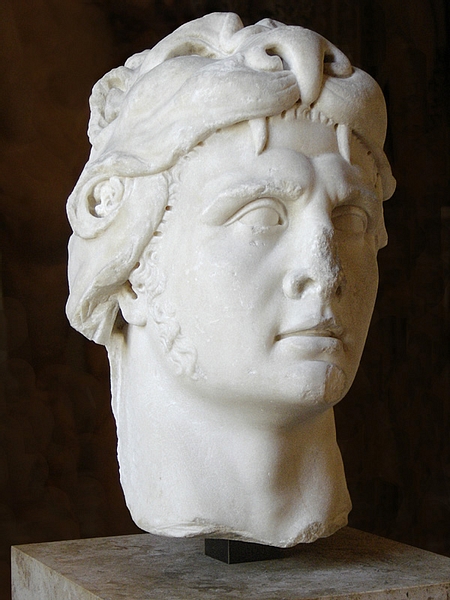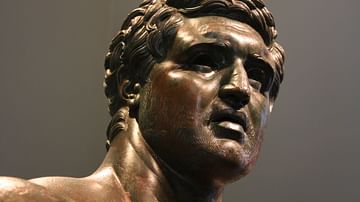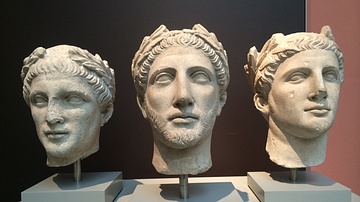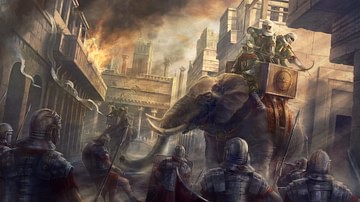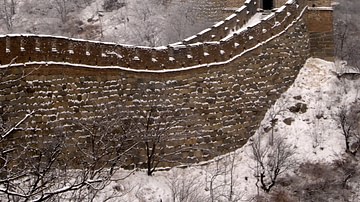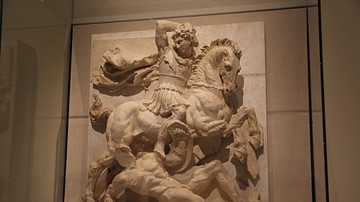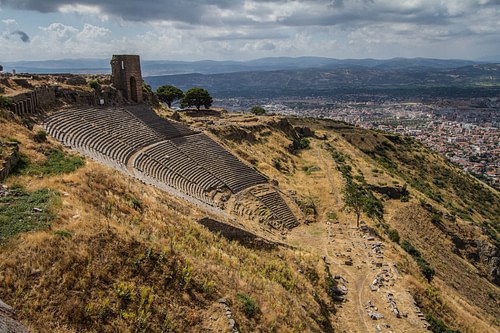
Pergamon (also Pergamum) was a major intellectual and cultural center in Mysia (northwest Asia Minor, modern-day Turkey) which flourished under the Attalid Dynasty (281-133 BCE) during the Hellenistic Period. It was the capital of the Kingdom of Pergamon and remained an important city for the Romans, Byzantines, and Ottoman Turks until its abandonment.
The city is probably best-known today as one of the seven churches of Asia in the biblical Book of Revelation 2:12-17 where it is referenced as the site "where Satan has his throne" and "where Satan lives" as Pergamon raised several significant structures, monuments, and temples to the Greek gods, the most famous being the Altar of Zeus now in the Pergamon Museum in Berlin. It is also well-known as the birthplace of the Greek physician Galen (l. 129-216), as the site of one of the greatest libraries of antiquity, and for its production (though not invention) of parchment.
The city is first mentioned in writing by Xenophon (l. 430 to c. 354 BCE) but was established by the 7th century BCE and was controlled by the Achaemenid Empire (c. 550-330 BCE) until the arrival of Alexander the Great c. 334 BCE. After Alexander's death, it was taken by his general Lysimachus (l. c. 360-281 BCE) and, after his death, by one of his commanders, Philetaerus (r. 282-263 BCE), founder of the Attalid Dynasty. His successors made the city one of the most powerful and culturally rich in the ancient Mediterranean with a library that rivaled Alexandria.
The last of the Attalid Dynasty, Attalus III (r. 138-133 BCE) died without an heir and bequeathed Pergamon to Rome. It began to decline under the Byzantine Empire and suffered severe damage in the conquest of the Ottoman Turks in the 12th century. By the 14th century, the city was in ruin and lay forgotten until the 17th century when European explorers first began publishing descriptions of it. Serious excavation of the site did not begin until the 19th century and continues in the present day near the modern city of Bergama, Turkey.
Historical & Mythic Origins
Archaeological evidence dates the origin of the settlement to the Archaic Period in Greece (c. 800-480 BCE), although finds have strongly suggested habitation by the Hittites in the 14th century BCE and human activity in the region even earlier. The site of the early settlement was high on a cliff to the north of the River Caicus and so was both easily defended and conducive to trade through its port of Elaea on the Caicus. The earliest mention of the established city comes from Xenophon in his Anabasis of c. 370 BCE, where, in Book VII, he relates how he led his men back from the doomed expedition against Persia to the city of Pergamos where he left them to other commanders before returning home to Athens.
According to the historian Pausanias (l. 2nd century), the city was known as Teuthrania originally, named after their king Teuthras. Prince Pergamus, grandson of the hero Achilles, came to the city where he defeated the despot Areius in single combat, claimed the city as his prize, and named it after himself (I.11.2). Another origin myth also attributes the founding of the city to Teuthras, who provided refuge to Telephos, son of Heracles (Hercules), and his mother Auge. Teuthras made Telephos his heir, and Telephos' son, Eurypylos, fought against the Achaeans (Greeks) in the Trojan War when they attacked the city, mistaking it for Troy. Both origin myths link the city with a major Hellenistic hero and were used by the Attalid Dynasty, especially, to legitimize their rule and provide an illustrious past for the city.
Persia & Lysimachus
Cyrus II (also known as Cyrus the Great, r. c. 550-530 BCE) took the region by 539 BCE as part of the Achaemenid Empire. Cyrus II was succeeded by Cambyses II (r. 530-522 BCE) who ignored the city as did his successor Darius I (also known as Darius the Great, r. 522-486 BCE), and, under his son, Xerxes I (r. 486-465 BCE), Pergamon was given to the Greek statesman Gongylos who had favored the Persians during Xerxes I's invasion of Greece in 479 BCE, serving as intermediary between Persia and Sparta. By the time Xenophon arrived in the city c. 399 BCE, Gongylos was dead, and he was hosted by his widow, Hellas, who was powerful enough to suggest Xenophon lead a raid on a neighboring Persian for booty, provided guides, and allowed 600 others to join in the raid against Xenophon's wishes.
Pergamon was involved in the revolt against the Achaemenid Empire in 362 BCE and was severely punished, then falls out of history until taken in the conquest of Persia by Alexander the Great at which time it became part of his expanding Macedonian Empire. After Alexander's death in 323 BCE, his empire was divided among his successors in the Wars of the Diadochi, who then fought each other for control of the whole. Pergamon was taken by Lysimachus as part of Anatolia (Asia Minor) and, while he waged war against Seleucus I Nicator (r. 305-281 BCE), another of the Diadochi, he placed his lieutenant Philetaerus in charge of the city.
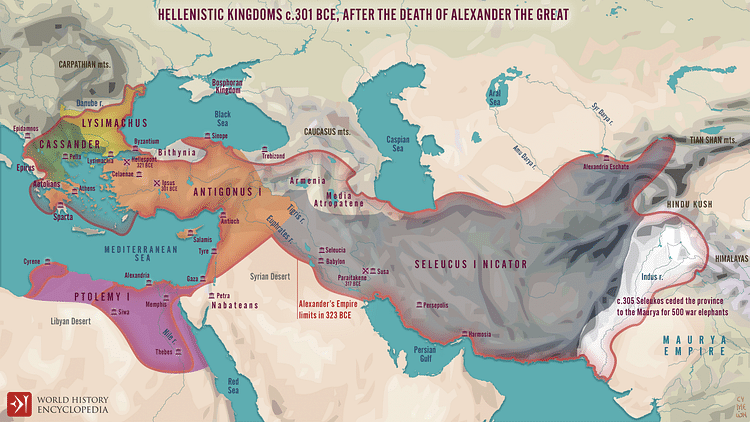
Lysimachus was killed in battle in 281 BCE and Seleucus I Nicator then claimed Anatolia as part of his Seleucid Empire before he was assassinated and was succeeded by Antiochus I Soter (r. 281-261 BCE). Pergamon was Lysimachus' treasury where, according to the historian Strabo, he held a sum of over 9,000 talents of silver (Geography, Book XIII.4). With Lysimachus and Seleucus I Nicator out of the way, Philetaerus should have sent word of this treasure to his new overlord but, instead, quietly spent it on improving not only his city but those of his neighbors, founding the Attalid Dynasty and establishing the Kingdom of Pergamon (c. 282-129 BCE).
Attalid Dynasty & Pergamon's Height
Philetaerus had defected from Lysimachus before the latter's death and had actually offered the treasury to Seleucus I Nicator but felt no obligation to do the same with his successor. A eunuch since youth, he adopted his nephew Eumenes I (r. 263-241 BCE) who continued the dynasty through his successors:
- Attalus I (r. 241-197 BCE)
- Eumenes II (r. 197-159 BCE)
- Attalus II (r. 159-138 BCE)
- Attalus III (r. 138-133 BCE)
- Eumenes III (r. 133-129 BCE)
The Celtic Gauls of Asia Minor had been a persistent problem for Pergamon under Lysimachus and Philetaerus as they regularly raided the region. Philetaerus had tried to resolve the problem through his generosity to his neighbors in helping them build stronger defenses, but the Gauls continued their raids until Eumenes I hired them as mercenaries and led them against Antiochus I Soter, defeating him at the Battle of Sardis in 261 BCE and liberating Pergamon from Seleucid rule. Eumenes I then expanded his territory, pacified the Celtic Gauls of Galatia though tribute, and concentrated on building projects. He kept Pergamon out of further military engagements for the duration of his reign.
He was succeeded by his first cousin, adopted as his son, Attalus I who refused to continue payments to the Gauls and drove the raiding parties back to Galatia in 232 BCE. In 230 BCE, the Gauls marched on Pergamon en masse to force Attalus I to resume paying tribute, but he defeated them and again drove them back to Galatia. The people of the city rewarded him with the epithet Soter (savior) and he was the first Attalid ruler to be proclaimed king. He forged a close alliance with Rome and fought for them against Philip V of Macedon (r. 221-179 BCE) in the Macedonian Wars, erected monuments to his victories (which included the famous statue The Dying Gaul), and officially recognized the Celtic Gauls' territory as Gallo-Graecia, an autonomous kingdom. He died of a stroke and was succeeded by his son Eumenes II.
Pergamon flourished under the reign of Eumenes II and his brother Attalus II. Eumenes II continued his father's alliance with Rome, helping to defeat Antiochus III (r. 223-187 BCE) at the Battle of Magnesia in 190 BCE, which led to the conclusion of the Roman-Seleucid Wars with the Treaty of Apamea of 188 BCE, forcing the Seleucids to withdraw from Anatolia. Eumenes II established the Library of Pergamon (situated north of the city's acropolis), rivaling the great Library of Alexandria with over 200,000 books.
Pergamon became a well-respected cultural center, drawing intellectuals and artists from around the Mediterranean world who contributed to the library's holdings as did wealthy citizens of the city. As many copies of books were made at the library, Egyptian papyrus became a valued commodity, but, since Alexandria was not especially interested in providing a rival library with materials, Pergamon took up the production of parchment. The English word parchment, in fact, comes from the Latin pergamenum referencing Pergamon, though, contrary to popular belief, the city did not invent parchment, only produced it in greater quantities than elsewhere in Anatolia.
Eumenes II also commissioned the famous Altar of Zeus (better known today as the Pergamon Altar) with its dramatic frieze in high relief depicting the Gigantomachy – the battle between the Titans and the Olympian gods. He renovated the Pergamon acropolis at the same time the Altar of Zeus was being constructed, building the Temple of Dionysus and either building or renovating the Temple of Athena, and also expanded and improved upon the hillside theater which could seat 10,000 spectators.
While Eumenes II was engaged in building projects and diplomacy with other kingdoms, Attalus II commanded the military and was a frequent – and popular – envoy to Rome. He commanded forces at the Battle of Magnesia and defeated the Kingdom of Pontus c. 179 BCE. In 172 BCE, when word reached Pergamon that Eumenes II, away at Rome, had been assassinated, Attalus II married his widow, Stratonice, to maintain the dynasty, but when Eumenes II arrived unharmed, he divorced her and handed power back to his brother.
He would show this same loyalty when Eumenes II fell out of favor with Rome for his independent negotiations with other principalities and they wanted to replace him with Attalus II. Attalus II refused the proposal but agreed to become co-ruler in 160 BCE, only assuming power in 159 BCE at his brother's death, and continued his policies and improvements to the city. At this point, Pergamon was at its height and was maintained, though not improved, during the reign of Attalus III who had no interest in ruling the kingdom and pursued his own interests. He preferred to let Rome handle the affairs of state and, having no heir, left the Kingdom of Pergamon to Rome in his will.
Officially, the Attalid Dynasty ends with Attalus III, but, c. 133 BCE, one Aristonicus, claiming to be the illegitimate son of Eumenes II, took the throne name Eumenes III and led a revolt against Rome which was crushed in 129 BCE, ending the Kingdom of Pergamon, which was then annexed to Rome. The kingdom was broken up and, at first, each principality was known as a "free city of Asia" under Roman administration before Anatolia became the Roman Province of Asia with Pergamon as its capital.
Roman Period
The Roman Republic had many other matters to keep it busy at first but then began to exert more direct control over the cities of Anatolia, increasing taxation and limiting personal freedoms. Eventually, a revolt was mounted by Mithridates VI, King of Pontus (r. 120-63 BCE) known as the Mithridatic Wars (89-63 BCE) which cost the lives of thousands. In one day in either 89 or 88 BCE, over 80,000 Romans and Italians were massacred in cities throughout Anatolia, including Pergamon, in an event now known as the Asiatic Vespers. Mithridates VI was defeated by the Roman general Pompey the Great in 63 BCE and took his own life to avoid capture.
Roman policy toward Anatolia continued unchanged as did the peoples' resentment toward these policies. Roman landowners and generals took what they wanted from the populace, usually without compensation, and one famous example of this, according to Plutarch, is a gift from Mark Antony (l. 83-30 BCE) to Cleopatra VII (l. c. 69-30 BCE). In 43 BCE, Antony, who was then in control of the region of Pergamon, gave Cleopatra the 200,000 books from the Pergamon library for the permanent collection at the Library of Alexandria.
As scholar Lionel Casson notes, whether this event happened is not as significant as the repetition of the story in antiquity which not only makes clear how the Romans regarded the property of the Anatolians but establishes that the Library at Alexandria still existed up through 43 BCE (Casson, 46). After Antony and Cleopatra were defeated by Octavian at the Battle of Actium in 31 BCE, he took the throne name Augustus Caesar (r. 27 BCE to 14 CE), established the Roman Empire, and relieved some of the tension in Anatolia by revising the districts and adjusting taxes. He also moved the capital of the Asia Province from Pergamon to Ephesus and is said to have returned some of the books taken from the library.
Under the Roman Empire, Pergamon initially flourished as the city was patronized by both Trajan (r. 98-117 CE) and Hadrian (r. 117-138 CE) who, it is thought, commissioned the structure known as the Red Basilica as a temple to the Egyptian deities Isis, Osiris, Serapis, or at least one of those three. At some point during the formative years of Christianity, a church was established at the site amidst pagan temples to Hera, Demeter, Athena, Dionysus, Zeus, Serapis, and a medical complex/sanctuary to the healing god Asclepius. The biblical Book of Revelation, understood to have been written during the reign of Roman emperor Diocletian (81-96 CE), rebukes Pergamon for compromising with pagan practices at the "throne of Satan" which is generally understood to mean the Altar of Zeus but could refer to the city generally.
Galen, among the most famous physicians of the ancient world (and personal physician to emperor Marcus Aurelius), was born in Pergamon in 129 CE, and, after his education in Smyrna, Alexandria, and elsewhere, returned in 157 CE to practice medicine in the Sanctuary of Asclepius. The city was severely damaged by an earthquake in 262 CE, which toppled some buildings and Pergamon began a slow decline afterwards. Around 663, the city was taken by Muslim Arabs who sacked it and moved on, and afterwards, it suffered several other setbacks during the era of the Byzantine Empire until it was taken by the Ottoman Empire c. 1300, after which it deteriorated further and was finally abandoned and forgotten.
Conclusion
The site first gained European attention in the 15th century, with increasing interest in the 18th century, and the first excavations began in the 19th century. The German engineer Carl Humann first visited the site in 1864/1865 while working on a road and returned in 1869 for the sole purpose of excavating the site. He found many pieces of the Altar of Zeus had been used by locals to build a wall and pieces from other buildings and monuments were reportedly burned in kilns. Humann was tasked in 1878 with the excavation of the site by the German and Ottoman governments, and the altar, as well as other significant structures from the site such as the marketplace entrance, were sold by the Ottoman Empire to Germany, which opened its Pergamon Museum in 1907.
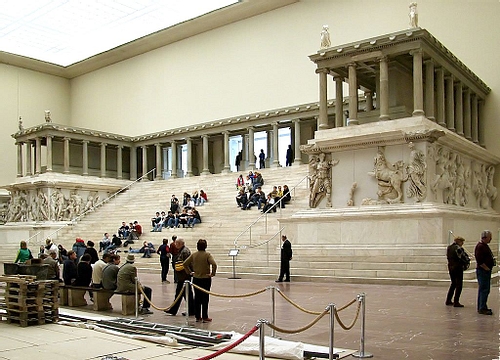
The Pergamon Museum in Berlin, Germany continues to house the Pergamon Altar, Marketplace entrance, and other artifacts from ancient Pergamon, while the site above present-day Bergama, Turkey attracts thousands of visitors every year to the ruins of the once great city. In 2014, the location of ancient Pergamon was declared a UNESCO World Heritage Site, and excavations continue there to the present, unearthing the history of one of the most significant cities of antiquity.
